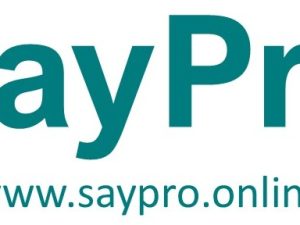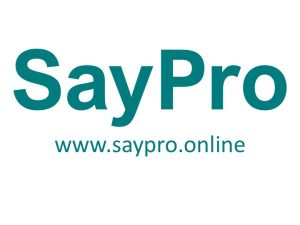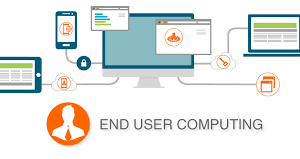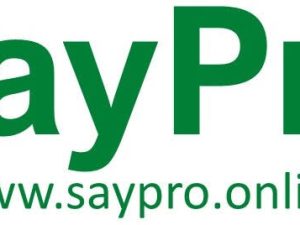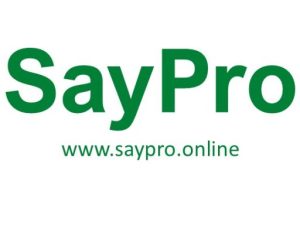SayPro National Occupational Certificate: Remotely Piloted Aircraft Systems (RPAS) Pilot Training Course 121161
- Description
- Reviews
SAQA Qualification ID: 121161
NQF Level: 5
Minimum Credits: 130
Accreditation Status: Awaiting or Registered with the QCTO
Delivery Mode: Blended (Theory + Practical)
Duration: 6 – 12 Months
Purpose of the Qualification
The purpose of this qualification is to provide learners with the knowledge, technical skills, and practical competencies required to operate Remotely Piloted Aircraft Systems (RPAS) safely and legally in various industries including agriculture, surveying, security, and media. Learners will acquire knowledge aligned with civil aviation regulations, flight planning, operations, and post-flight procedures.
Target Audience
-
Aspiring drone pilots
-
Surveyors, photographers, and agricultural consultants
-
Youth and women entering the aviation or drone industries
-
Individuals working in construction, mining, or security sectors
-
Emergency responders and disaster management workers
Entry Requirements
-
Grade 12 or equivalent (with Maths and English preferred)
-
Basic computer literacy
-
Valid Class 3 or 4 medical certificate (aviation standard)
-
Must be 18 years or older
-
No criminal record (required for aviation license application)
Learning Outcomes
Upon completion, learners will be able to:
-
Understand and comply with South African Civil Aviation Authority (SACAA) RPAS regulations.
-
Plan and conduct RPAS flights safely and legally.
-
Operate various RPAS types for commercial and non-commercial purposes.
-
Identify and mitigate flight risks in diverse environments.
-
Apply meteorological, navigational, and airspace knowledge in real flight scenarios.
-
Log and report flight data as per aviation standards.
Course Structure and Modules
Module 1: Introduction to RPAS and the Aviation Environment
-
RPAS history and evolution
-
Aviation terminology and classifications
-
RPAS types and uses
-
Ethics and safety in unmanned aviation
Module 2: Aviation Law and Regulations
-
SACAA Regulations Part 101
-
Licensing and certification process
-
Restricted and uncontrolled airspaces
-
RPAS operational limitations and penalties
Module 3: Principles of Flight and Aircraft Systems
-
Aerodynamics of RPAS
-
Powerplants, propellers, and airframes
-
RPAS component systems and payloads
-
Redundancy and safety systems
Module 4: Meteorology and Navigation
-
Weather effects on drone operations
-
Wind, temperature, and pressure systems
-
Map reading and coordinate systems
-
GPS and manual navigation
Module 5: Human Factors and Airmanship
-
Decision-making and situational awareness
-
Fatigue, stress, and performance
-
Crew Resource Management (CRM)
-
Communication and teamwork
Module 6: Flight Planning and Operations
-
Pre-flight planning and checklist procedures
-
Flight logging and reporting
-
Emergency and contingency planning
-
Post-flight inspections and data analysis
Module 7: Practical Flight Training
-
Hands-on RPAS flying in controlled environments
-
Simulated commercial applications (mapping, inspections, etc.)
-
Emergency scenarios and drills
-
Final performance evaluation
Assessment Strategy
-
Written knowledge tests
-
Practical flight assessments
-
Logbook submissions
-
Final summative evaluation (oral + practical)
-
Continuous feedback and mentor reviews
Workplace Integration and Internships
-
Learners will complete a work-based learning component with approved RPAS companies or SayPro partners.
-
Real-world missions include: surveying, agricultural spraying, asset monitoring, and aerial photography.
Certification and Recognition
Upon successful completion, learners will receive:
-
SayPro Certificate of Completion
-
National Occupational Certificate: RPAS Pilot (ID: 121161)
-
Support with SACAA RPAS Pilot License Application
Career Opportunities
-
Commercial Drone Pilot
-
Aerial Survey Technician
-
Agricultural Drone Operator
-
Security Surveillance Operator
-
Media and Film Aerial Camera Operator
-
Emergency and Disaster Drone Responder
| PURPOSE AND RATIONALE OF THE QUALIFICATION |
| Purpose: The purpose of this qualification is to prepare a learner to operate as a Remotely Piloted Aircraft Systems (RPAS) Pilot. A Remotely Piloted Aircraft Systems Pilot operate the start-up, lift-off, flight and set down of a remotely piloted aircraft system under 7kg. A qualified learner will be able to:
|
| LEARNING ASSUMED TO BE IN PLACE AND RECOGNITION OF PRIOR LEARNING |
| LEARNING ASSUMED TO BE IN PLACE AND RECOGNITION OF PRIOR LEARNING Recognition of Prior Learning (RPL):
|
| RECOGNISE PREVIOUS LEARNING? |
| Y |
| QUALIFICATION RULES |
| This qualification is made up of compulsory Knowledge, Practical Skill and Work Experience Modules:
Knowledge Modules
|
| EXIT LEVEL OUTCOMES |
| 1. Demonstrate the ability to remove, upgrade and install software and firmware used for remotely Piloted aircraft systems according to manufacturer’s specifications and procedures. 2. Set up, dismantle and operate the lift off and landing of a remotely piloted aircraft system according to standard operating procedures and within legal parameters. 3. Fly remotely piloted aircraft systems according to standard operating procedures and within legal parameters. |
| ASSOCIATED ASSESSMENT CRITERIA |
| Associated Assessment Criteria for Exit Level Outcome 1: ELO1: Demonstrate the ability to remove, upgrade and install software and firmware used for remotely Piloted aircraft systems according to manufacturer’s specifications and procedures.
|
| INTERNATIONAL COMPARABILITY |
| The Occupational Certificate: Remotely Piloted Aircraft Systems Pilot was compared to that of the foremost countries in RPAS technology and repairers, such as the United Arab Emirates (UAE) and United States of America (USA). These countries offer comprehensive Remotely Piloted Aircraft Systems (RPAS) or Unmanned Aerial Vehicle (UAV) qualifications that span across the disciplines in our qualification. RPAS are used and repaired all over the world, but these countries have been chosen as they have systems with most similar qualification structures to the Republic of South Africa (RSA).
These qualifications focused on developing learners towards a wider range of related skill sets including, flying operation, launch and recovery systems and components. Learning programs and qualifications registered by a qualification’s authority on a national qualifications’ framework were selected for this comparison. UNITED ARAB EMIRATES (UAE):
|
| ARTICULATION OPTIONS |
| This qualification provides opportunities for horizontal and vertical articulation options.
Horizontal Articulation: Vertical Articulation: Diagonal Articulation |
Recent Posts
- SayPro Post-Event Reporting & Evaluation: Send out surveys and feedback forms to participants and sponsors to assess their satisfaction and gather insights for improvement.
- SayPro Create post-event reports using SayPro’s analytics tools, summarizing the effectiveness of the partnerships formed during the event.
- SayPro Partnership Agreement Management: Use SayPro’s platform to manage and monitor the success of strategic partnerships after the event.
- SayPro Partnership Agreement Management: Facilitate the signing of partnership agreements and ensure the correct documentation is processed via SayPro.
- SayPro Data Management: Leverage SayPro’s data management tools to track registration, partnership progress, and media distribution during the event.
